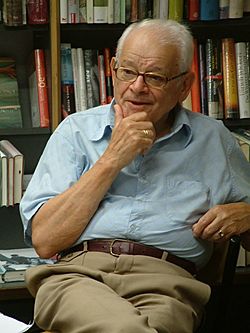Jules Schelvis facts for kids
Quick facts for kids
Jules Schelvis
|
|
|---|---|

Schelvis in 2006
|
|
| Born | 7 January 1921 Amsterdam, Netherlands
|
| Died | 3 April 2016 (aged 95) Amstelveen, Netherlands
|
| Nationality | Dutch |
| Occupation | Historian, author, Nazi hunter |
| Spouse(s) |
Rachel Borzykowski
(m. 1940; died 1943) |
Jules Schelvis (born January 7, 1921 – died April 3, 2016) was a Dutch Jewish historian and writer. He was also a printer. Jules was a Holocaust survivor, meaning he lived through the terrible events of the Holocaust.
He was the only person to survive out of 3,005 people. They were on a train from Westerbork concentration camp to Sobibor extermination camp. Jules was chosen to work at a camp called Dorohucza nearby. He is famous for his books and research about Sobibor. For his important work, he received special awards. These include an honorary degree from the University of Amsterdam.
Contents
Early Life and Family
Jules Schelvis was born in Amsterdam, Netherlands. His family was Jewish, but they did not strictly follow religious rules. After finishing high school, Jules learned to be a printer. He worked at a printing office in Amsterdam.
German Occupation
When the German army took over the Netherlands, Jules lost his job. This happened because he was Jewish. He then worked for different newspapers. He also joined a youth group. There, he met Rachel Borzykowski.
Jules and Rachel became very close. Rachel's family was from Poland. Their home was a place where Yiddish culture was celebrated. Jules and Rachel got married in 1940. They hoped this would protect her family from being sent away.
Deportation and Survival
On May 26, 1943, Jules and his family were taken from their home. They were sent to Westerbork transit camp. They stayed there for six days. Then, they were put on a train to Sobibor extermination camp.
The Journey to Sobibor
There were 3,005 Dutch Jewish people on this train. It was the 14th transport to Sobibor. The journey lasted for four days. When they arrived, Jules was chosen to work. He was sent to Dorohucza labor camp. Sadly, his family and Rachel's family did not survive.
Life in Labor Camps
At Dorohucza, Jewish people from Poland and the Netherlands were forced to work. They had to build farms in very bad conditions. Jules survived because he asked to meet the camp leader. The leader knew another camp needed a printer.
However, Jules was sent to Lublin airfield camp instead. There, he had to build army barracks. Later, he was moved to Radom Ghetto. His job was to put together a printing press. It had been taken apart for transport from Warsaw.
Conditions in Radom were much better. The Red Army (Soviet army) was getting closer. So, Jules was forced to go on a death march. This was a long, difficult walk to Tomaszów Mazowiecki. From there, he eventually reached Vaihingen, near Stuttgart. The French army freed him on April 8, 1945.
Later Life and Legacy
After the war, Jules Schelvis became very important. He was a plaintiff (someone who brings a lawsuit) in trials. He was also an expert witness (someone who gives expert information). He helped bring to justice people who committed crimes during the Holocaust. These included Karl Frenzel and John Demjanjuk.
Jules founded the Stichting Sobibor. This is a foundation dedicated to remembering Sobibor. He also wrote several books. These books share his memories and historical research about the camp.
Notable Works
- Sobibor: A History of a Nazi Death Camp (2014) Bloomsbury Academic. ISBN: 978 14 7258 906 4
- Vernietigingskamp Sobibor (1993) Amsterdam: Bataafsche Leeuw. ISBN: 978 90 6707 629 6
- Binnen de poorten, 1995, Amsterdam: Bataafsche Leeuw. ISBN: 978 90 6707 369 1
- Sobibor. Transportlijsten, 2001, Amsterdam: Bataafsche Leeuw. ISBN: 90 6707 516 7

